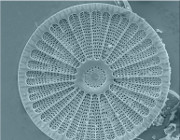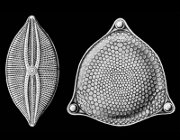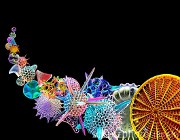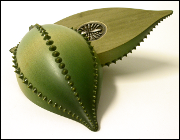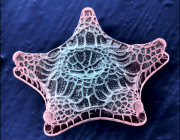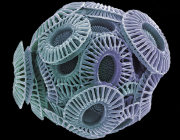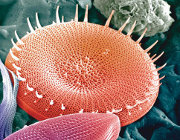Home :: List of Publicly Available Datasets :: Aplanochytrium stocchinoi GSBS06
Aplanochytrium stocchinoi GSBS06
Downloads:
| Principle Investigator(s) | Jackie Collier |
|---|---|
| External sample ID | Aplano. GSBS06 horse serum |
| NCGR Sample ID | MMETSP1347 |
| Sample accession number | CAM_SMPL_002872 |
| Assembly accession number | CAM_ASM_000690 |
| Combined Assembly Name | Aplanochytrium-stocchinoi-GSBS06 |
| Genus | Aplanochytrium |
| Species | stocchinoi |
| Strain | GSBS06 |
| Clonal | Yes |
| Axenic | Yes |
| Prelim. NCBI Taxon ID | 215587 |
| 18S rRNA | |
| Importance of organism and transcriptomes | The labyrinthulomycetes (including labyrinthulids, oblongichytrids, thraustochytrids, and aplanochytrids) are ubiquitous, diverse, and abundant marine protists (e.g. Collado Mercado et al. 2010 and references therein). They are thought to live mainly as saprobes, obtaining their nutrition from non-living particulate organic matter (POM) of algal, higher plant, or animal origin. Thus, while labyrinthulomycetes are not fungi in a taxonomic sense, they function as fungi in an ecological sense, likely playing important roles in the decomposition of marine POM. This isolate, Aplanochtyrium GSBS06, was isolated from sediment collected in Great South Bay (Long Island, NY, USA) in July 2008. The 18S rDNA sequence of this strain is ~99% identical to Aplanochytrium PBS07, but the two strains also show different growth forms and media preferences. Comparative analysis of the genes expressed by this organism during growth on a variety of substrates, and comparison of GSBS06 with PBS07, will provide unprecedented insight into the physiology and role of aplanochytrids in marine ecosystems. |
| Additional citations and references | Collado Mercado, E., Radway, J. C. & Collier, J. L. 2010. Novel uncultivated labyrinthulomycetes revealed by 18S rDNA sequences from seawater and sediment samples. Aquatic Microbial Ecology 58:215-28. Damare, V. & Raghukumar, S. 2010. Association of the stramenopilan protists, the aplanochytrids, with zooplankton of the equatorial Indian Ocean. Mar. Ecol. Prog. Ser. 399:53-68. Yokoyama, R. & Honda, D. 2007. Taxonomic rearrangement of the genus Schizochytrium sensu lato based on morphology, chemotaxonomic characteristics, and 18S rRNA gene phylogeny (Thraustochytriaceae, Labyrinthulomycetes): emendation for Schizochytrium and erection of Aurantiochytrium and Oblongichytrium gen. nov. Mycoscience 48:199-211. Leander CA, Porter D (2000) Redefining the genus Aplanochytrium (Phylum Labyrinthulomycota). Mycotaxon 76:439-444. Leander CA, Porter D (2001) The Labyrinthulomycota is comprised of three distinct lineages. Mycologia 93:459-464. |
| Environmental Data | |
| Primary citation for organism's characterization, if available | Moro I, Negrisolo E, Callegaro A, Andreoli C. 2003. Aplanochytrium stocchinoi: a new Labyrinthulomycota from the southern ocean (Ross Sea, Antarctica). Protist 154(3-4):331-40. |
| Latitude | 40.7 |
| Longitude | -73.1 |
| Depth (m) | 1 |
| Salinity (psu) | 25 |
| Collection date | 10-JUL-08 |
| Sample collection site | OTHER |
| Other collection site info | Great South Bay, Long Island, NY |
| Sample material (e.g. "seawater," "sediment," etc.) | Sediment |
| ENVO term for habitat - primary term | Acquatic: marine |
| ENVO term for habitat - secondary term | Other |
| Habitat description | Sediment from Great South Bay, Long Island, NY, USA |
| Other environmental metadata available | none available |
| Other environmental metadata available | none available |
| Habitat | marine habitat |
| Country | UNITED STATES |
| Experimental Data | |
| Date of experiment | 24-MAY-12 |
| Growth medium | artificial seawater with 1% horse serum (0.8% agar plates) |
| Modifications to growth medium | artificial seawater (25 grams per liter Instant Ocean) plus 0.8% agar autoclaved, then filter sterilized horse serum (1% vol:vol) added just before pouring plates |
| Temperature (ºC) | 23 |
| Salinty (psu) | 25 |
| pH | 8 |
| Pressure (atm) | 1 |
| Investigation type | Eukaryotes |
| Other experimental metadata available | Harvested 502 mg (wet weight) biomass from 50 plates after 16 days of growth |

